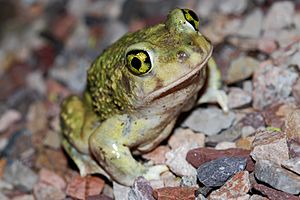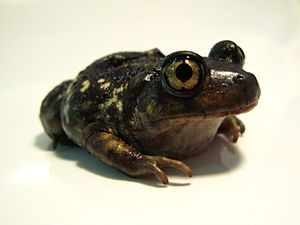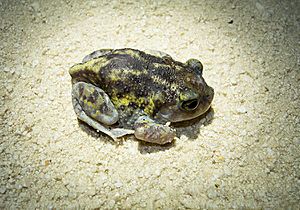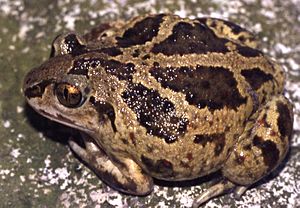American spadefoot toads facts for kids
Quick facts for kids American Spadefoot Toads |
|
|---|---|
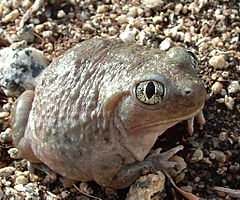 |
|
| Western Spadefoot Toad (Spea hammondii) | |
| Scientific classification | |
| Kingdom: | |
| Phylum: | |
| Class: | |
| Order: | |
| Suborder: | |
| Family: |
Scaphiopodidae
Cope, 1865
|
| Genera | |
|
Scaphiopus |
|
 |
|
| Distribution of Scaphiopodidae (in black) | |
The American spadefoot toads are a small group of toads. They belong to the family Scaphiopodidae. These toads live only in North America. There are only seven different types, or species, of American spadefoot toads.
These toads look like most frogs that dig. They have a round body and short legs. Their eyes stick out a bit. As their name suggests, they have hard bumps on their feet. These bumps help them dig into the ground.
Like many digging frogs, they dig backwards. They are different from "true" toads. American spadefoot toads have pupils that are shaped like a line, not round. They also do not have special glands behind their eyes called parotoid glands.
American spadefoot toads live on land when they are not underground. They are usually dull colors like grey, green, or brown. This helps them hide in their dry homes.
Contents
Where Do Spadefoot Toads Live?
The seven types of American spadefoot toads live in different parts of North America. The Eastern Spadefoot is the only one found east of the Mississippi River. It lives from New England down to southern Florida.
The Great Basin Spadefoot and Plains Spadefoot live in western Canada and the northwestern U.S. The Plains Spadefoot also lives in Texas and northern Mexico.
The Couch’s Spadefoot, Hurter’s Spadefoot, and New Mexico Spadefoot live across the southern and southwestern U.S. The Couch’s and Hurter’s also reach into Mexico. The Western Spadefoot is mostly found in California. It also extends into Mexico.
Scientists think these toads moved to North America from South America. This happened because the climate changed. They likely came as one type of toad. Then they split into different species as they spread out. They adapted to their new homes.
These toads like marshy places. But they only go into the water to lay their eggs. They stay buried in the soil most of the year. This helps them deal with changing weather.
What Do Spadefoot Toads Eat?
American spadefoot toads have a special diet. What they eat changes as they grow. Adult toads eat small creatures without backbones. These are called invertebrates. They enjoy flies, crickets, caterpillars, moths, spiders, centipedes, millipedes, earthworms, and snails.
Young spadefoot toads, called tadpoles, eat based on their surroundings. When they are very young, they eat tiny water plants called plankton. After a few days, they start eating meat. This means they become carnivorous.
American spadefoot toads lay their eggs in shallow water. This water can dry up quickly. This causes stress for the tadpoles. They face drying water, rising temperatures, less food, and crowded spaces.
Helping Spadefoot Toads
The Eastern Spadefoot toad was listed as endangered in Pennsylvania in 2005. It is also endangered in Ohio, Connecticut, and Rhode Island. At that time, they were found in only two known places. This is surprising because American spadefoot tadpoles grow into adults faster than almost any other amphibian.
One reason for their small numbers is that their pools often dry up. This happens before the tadpoles can fully change into toads.
So far, efforts to protect them have helped stop their homes from being lost.
In 2012, a couple learned that their land might be a spadefoot toad home. They wanted to build houses there. But because of a plan by a group called Berks County Conservancy, they needed state approval. They also had to hire an expert. This person would check the land for signs of spadefoot toad homes.
These efforts have made people more aware of endangered spadefoot toads. But more work is still needed. This will help make sure the Eastern Spadefoot toad has a safe future.
See also
 In Spanish: Sapos pata de pala para niños
In Spanish: Sapos pata de pala para niños


